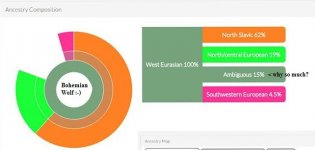The British & Irish component, although peaking in the British Isles, might represent Germanic ancestry of Danish, Saxon and Frisian origin in the Low Countries, where Insular Celtic ancestry in very low. 23andMe simply seems to have amalgamated all ancestries found in Ireland and Scotland to create this component, including Anglo-Saxon DNA. It should ideally be split in two to clearly differentiate Celtic from West Germanic ancestry. Outside the British Islesand France, this admixture peaks in Northwest Germany and Frisia, the ancient homeland of the Anglo-Saxons. It is higher in Flanders (23.5%, ranging from 16% to 38%) higher than Wallonia (17.5%, ranging from 6% to 30%), which makes sense since the Germanic ancestry of Flemings comes from both the Saxons and Franks, while in Wallonia is comes mostly from the Franks. Interestingly, the Dutch provinces of Noord-Brabant and Limburg get a closer score (17%) to Wallonia, and also have more Frankish ancestry historically. The northern provinces score 20 to 25%, similar to Denmark and Flanders. The Dutch average is 25%.
The French & German shows the reverse pattern of the British & Irish component. This admixture probably correspond to a blend of Gaulish and Frankish ancestry. It is in fact higher in Wallonia (45%, ranging from 28% to 70%) than in Flanders (36%, ranging from 10% to 46%). The Netherlands also has a strong north-south gradient, with 40% in the south and 18% in the north. The French and German admixture peaks in Wallonia, southern Germany and Switzerland, a region were the Franks and Alemani/Suebi mixed with the descendants of the La Tène Celts.



